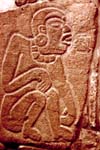Out
of the Past Series -- Annenberg / CPB Exhibits
Use this humanistic approach to archaeology and
anthropology to make connections between past civilizations and
modern societies, including how societies function and change. This
series helps bring cultural ecology to light using physical evidence
and scientific detective work. On-site filming at the spectacular
Classic Maya center of Copán, Honduras, shows archaeologists reconstructing
this ancient society. In addition, past and present cultures in
Central and North America, Africa, Europe, and the Middle East are
explored. Produced by Pennsylvania State University and WQED/Pittsburgh.
1993.
"New Worlds"
"The Age of Discovery 500 years ago revealed
a broad range of cultures, from the vast empires of the Aztecs
and the Incas to roving bands of hunter-gatherers. This provided
irrefutable evidence that cultures, like biological species, have
evolved independently and on a global scale."
Terms / Concepts / Features
- cultural ecology
- methods
- comparative methods
- ethnographic analogy
- autosacrifice
- warfare
- ritual
- political conquest
- irrigation
- Oaxaca pottery
- clay figurines
- forensic archaeology
- siatic notch
- pollen analysis
- maguey cactus
- nopal cactus
- UNIDAD water cooperative (canalero)
- "dedicatory burials"
- occupational specialization
- Quicatlán
Notes
- The Copán dynasty endured
for almost 400 years
- 10,000 ybp people began to live in permanent settlements
- they specialized in their tasks
- and divided into poor and rich and relationship became "evermore
complex"
- cactus = "starvation food" (is this really so?)
- At about A.D. 700 three civilizations flourished: Tikál, Teotihuacán, and Monte
Albán
- ca. A.D. 800 all over the Maya lowland they stopped building
pyramids . . .
- The population went from 300,000 or so to ". . . a few tens
of thousands."
- warfare changed from ritual to conquest
- by ca. A.D. 700 Middle America had been getting its
terrritory by conquest
- agriculture -----> cities
- but how did farming figure in the new World?
- about 5000 B.C. maize began to be cultiated
- corn can be dried and stored and can thus be used year round
- corn can be grown in abundance
- pollen analysis reveals clear evidence of corn fields
- Between the 11th and 13th centuries A.D. the Anasazi abandonned
the Southwestern part of the current United States
- Until A.D. 500 the Indians of the Tewa Puebla were hunters. shortly
after they settled down and to plant corn
- Anasazi
- salt problem with irrigation
- By the 17th century B.C. the people had largely abandonned ancient
Mesopotamia
- For most of the time archaeology focused on the elite
- now, at Copán, they
are changing and they are focussing on the common person
- "Who were the common men and women who lived here?"
becomes an important archaeological question
- James Mitchner once noted that in the history of the world there
have been about 75 civilizations, but that only a handful of them
lasted a thousand years or more
- most civilizations lasted 200 to 400 years
Cultures
- Copán
- "Acropolis"
- Butz' Chan "Smoke Serpent" (fire-eating serpent) A.D. 578-628,
11th king
- Fez, Morocco
- Maya
- Monte Albán (Oaxaca)
- ca. 200,000 people
- 30,000 in city center, supported by + 100,000 or more in the
surrounding valley
- Zapotec, later Mixtec
- writing
- art
- "Danzantes"
- 300 or more male figures on one building
- !Kung San (AKA Khoisan,"Bushmen"),
South Africa
- they call themselves zhun/twasi, "ourselves"
- Tewa, Peblo
- Teotihuacán
- Tlacuala -- typical appartment compound of the time
- 125,000 +
- 20 X the size of ancient Copán
- 4 X the size of Monte Albán
- by A.D. 600 it was the most complex society in all of Mesoamerica
- on the south side between 80 and 100 permanent springs allowed
irrigation for 7,000 - 8,000 acres
- Tehuacán
- Purron Cave
- El Riego layer = 8,600 ybp
- July - November cave was occupied, 5,000 B.C.
- Ajalpán, 3,000 B.C.
- Cuicatlán
- Tikál
- Zapotec (Monte Albán)
- Sumer, Ancient Mesopotamia
Sites
- Roman Fort
- Chalco Canõn
- Tewa
- Mashkan Shapia
- Egypt
- Ancient Mesopotamia, "The First Cradle of Civilization"
- San Joaquin Valley
- Monte Albán
- Middle American captives were shown naked s a sign of humiliation
- In Middle America an upside-down head referrs to conquest
- some of the earliest writings in Monte
Albán
- hill glyph = place
- symbol = particular place conquered by Monte
Albán
- ca. 200,000 people in the state by A.D. 800
- Fez, Morocco
Individuals
- Warren T.D. Barbour
- Frederic Catherwood (1839)
- Angel Garcia Cook (1839)
- William Sanders
- Stephens
- William Fash
- Robert Hunt (archaeologist, expert on irrigation)
- William Lipe
- Scotty McNeish
- Elsa Redmond
- William Sanders
- Linda Schele (epigrapher)
- Michael Spence
- Charles Spencer
- John L. Stephens (1840s)
- Incidents of Travel in Central America, Chiapas, & Yucataán
- Rebecca Storey
- Rena Swentzell
- Jeffrey Dean
- Elizabeth Stone
- the 16th Rular of Copán,
on Altar Q
- David Webster (archaeologist)
Resources
|

